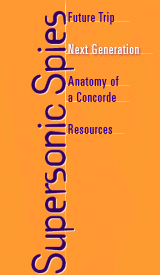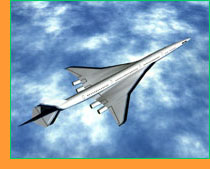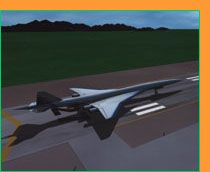 |
 |

|
Next Generation

The supersonic passenger jet of the future is taking shape. Technology to make it possible is
being developed as part the High-Speed Research Program led by NASA, and involving all the major
American aerospace companies.
In December 1995, NASA focused the technology development on a single aircraft concept.
This aircraft, the Technology Concept Airplane, is not an airplane that will be built.
Instead, it serves as a common reference point for research. To see what this aircraft
might look like in flight check out Future Trip.
To be profitable, the plane will have to carry more than twice as many passengers as the Concorde,
operate at higher speeds, span greater distances, use less fuel, run more quietly and produce less
 pollution. Ground-breaking technology is being developed to meet these challenges: new structural
materials able to withstand the kinetic heat generated at Mach 2.4; a SuperVIEW Cockpit,
which will replace forward cockpit windows with large format video displays that offer
enhanced guidance cues; an environmentally sensitive supersonic propulsion system; and
wings that achieve laminar, or smooth, air flow during supersonic flight.
pollution. Ground-breaking technology is being developed to meet these challenges: new structural
materials able to withstand the kinetic heat generated at Mach 2.4; a SuperVIEW Cockpit,
which will replace forward cockpit windows with large format video displays that offer
enhanced guidance cues; an environmentally sensitive supersonic propulsion system; and
wings that achieve laminar, or smooth, air flow during supersonic flight.
For two different perspectives on this research effort, read on.

|

|

Howard Moon
Aerospace Consultant and author of Soviet SST.
|

Wally Sawyer
Director of NASA High Speed Research Program
|
NOVA: Why in your view did the Concorde not become a more popular form of transportation?
HM: I think it was thoroughly popular, it just wasn't economically practical. I mean, as an
icon it was a symbol of an age of technological expansion and open horizons. In terms of
people using it, which is what airline people have to worry about, the money wasn't there.
Its R&D costs came to something like $2.5 billion dollars—and that would be in 1982 dollars.
And the French and British taxpayers simply picked up the tab on that. It was never recovered.
It started out with about eight routes, only two of which proved viable in the sense that you
could make an operational profit—that is, you could make enough money on the runs to pay
off your costs. And that was essentially Paris to New York and London to New York.
Everything else had to be withdrawn.
NOVA: Can the next generation of supersonic transport planes conquer these economic problems?
HM: In my opinion, it would be highly unlikely because the planes are much more complex.
The last figures I saw said it would cost $6 to $10 billion dollars simply to develop the
next generation. The people who are going to be using this airliner and paying these premiums
are very privileged business class, first class passengers anyway. And the question is—who is
going to pay for this thing? I don't see any government today doing what the French and British
did in the '60s. You look at the billions of dollars this thing is going to cost. There's a
basic issue of social equity. Are taxpayers going to basically pony up billions of dollars so
that very privileged businessmen can get to their appointments two hours quicker? I don't see
that happening.
NOVA: Can traveling at Mach 2.4 ever be fuel efficient?
HM: Let's look at what actually flew. The Concorde burns a ton of fuel for every
single passenger that flies across the Atlantic. A hundred passengers, a hundred tons.
The TU-144, the Soviet example I'm more familiar with, was at least twice as thirsty as
that. So at least at the level of that kind of technology it's a tremendous waste. The
issues of efficiency, issues of the environment, issues of burning up a scarce resource—aviation fuel—so someone can get to their appointments two or three hours in advance?
I just don't see there being much public support for that. You're serving an elite population.
What is the great unknown is will the new technologies they're talking about, in fact, solve
these problems. And I don't know. I don't think the people who are pushing them really know.
NOVA: Why do you think NASA, Boeing and others are conducting research in
supersonic transport?
HM: I've had cynical friends that went up to Moscow when the United States rented the
TU-144's to use for high altitude research, who said it was simply diplomacy. It was a means to
keep the aerospace community busy and to show good will toward the Russians. I guess the answer is,
this is what they do. This is the business they are in. They are supposed to be dealing with
radical new approaches to aviation and aerospace, and I have no trouble with that. I do see
troubles emerging when there is serious talk about trying to make these things commercial
propositions. When we had a Cold War on our hands, when there was a legitimate national defense
interest for very rapid bombers, or at least someone argued there was, there was a much stronger
case for developing the technology for the bombers, which could be handed over to things that became
supersonic transports. And were there still a kind of bipolar conflict on a global scale like we
had until about 1991, you could make a stronger case for developing very high powered units for
military ends. For strategic purposes. But that's gone now. And my own reading of the situation
on a sociological level—we have deeper social problems that are intractable and we should
throw our national resources in that direction.
|
NOVA: Why wasn't the Concorde a more popular form of transportation?
WS: I think it was a popular form of transportation for those that could afford it.
Currently, the ticket price runs about $7000, but the Concorde still enjoys a high load factor.
It seats roughly 100 people and they run anywhere between 60 and 80 percent full on their route
structure. So it enjoys a good economic return for those that can afford that price. It was
not an economic success from the standpoint of a manufacturer building it. The government
underwrote all of the development costs and then they wrote it off. So the operating airline
never had to pay that back.
NOVA: What about the next generation of supersonic planes? Will they be able to solve
these economic problems?
WS: The goal of our program is to develop an economically viable and an environmentally
acceptable airplane. Our goal is to design a supersonic plane where the ticket price no more
than 20 percent greater than a sub-sonic ticket. You might charge 21 or 22 percent in business
class and charge only 18 percent in the general traveler's class, but the overall balance is
that the ticket price would not be more than 20 percent of what it would be for sub-sonics.
In order to do this, the plane is going to have to seat anywhere from 280 to 300 passengers.
NOVA: Can you talk a little bit about the progress you're making with regard to sonic
booms and emissions?
WS: We cannot lick the sonic boom problem, to a low enough level, that we're going to
be able to fly over vastly populated areas at supersonic speeds. Remember that one of the key
goals of this program is making the airplane economically viable. You can develop an airplane
that has very very low boom levels—something very long and slender. But then you can't get
enough people on board and you violate the first goal of making it economically viable.
What we can do is soften the boom.
NOVA: What about high altitude emissions?
WS: It's all in the combuster. You have to have more efficient burning in order to reduce
the nitrogen oxide. Our goal is to put out no more than 5 grams of nitrogen oxide for every
kilogram of fuel burned. And that's a very aggressive goal. But we just feel that we're
going to have to do things like this in order to make this airplane acceptable. We're going
to have to make breakthroughs in technology that allow us to get down to those levels.
NOVA: Can flying at Mach 2.4 ever be fuel efficient?
WS: There's no question that as you go faster, you burn more fuel. This aircraft carries a
lot of fuel, it burns a lot of fuel. But if you think of a 747—about half the weight of
that aircraft is fuel. So you're going to see the same sort of thing in the supersonics.
Our first generation engines won't be as efficient—but as time goes on they'll become
more efficient. That's just the way propulsion systems work. But you will pay a price
in fuel because of speed.
NOVA: If a passenger wanted to arrive in Asia during the day, would he have to leave the
U.S. in the middle of the night?
WS: We're talking about taking what is now a 10-hour trip and doing it in less than half
the time—about four, four and half hours. Today, you have to spend two days traveling to
conduct one day of business in Asia. What we're talking about is leaving the U.S. at 8:00am,
arriving in Narita at 6:00am, conducting a full day of business, getting back on the plane and
being back in the US at 6:00pm. Now granted, that's a long day, but it's much more efficient
than the current situation.
|
Photos: (1,2,4) NASA
Future Trip |
Next Generation |
Anatomy of the Concorde
Teacher's Guide |
Resources |
Transcript |
Supersonic Spies Home
Editor's Picks |
Previous Sites |
Join Us/E-mail |
TV/Web Schedule
About NOVA |
Teachers |
Site Map |
Shop |
Jobs |
Search |
To print
PBS Online |
NOVA Online |
WGBH
© | Updated November 2000
|
|
|


 pollution. Ground-breaking technology is being developed to meet these challenges: new structural
materials able to withstand the kinetic heat generated at Mach 2.4; a SuperVIEW Cockpit,
which will replace forward cockpit windows with large format video displays that offer
enhanced guidance cues; an environmentally sensitive supersonic propulsion system; and
wings that achieve laminar, or smooth, air flow during supersonic flight.
pollution. Ground-breaking technology is being developed to meet these challenges: new structural
materials able to withstand the kinetic heat generated at Mach 2.4; a SuperVIEW Cockpit,
which will replace forward cockpit windows with large format video displays that offer
enhanced guidance cues; an environmentally sensitive supersonic propulsion system; and
wings that achieve laminar, or smooth, air flow during supersonic flight.

